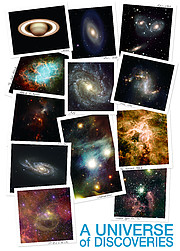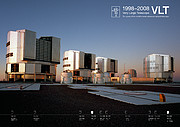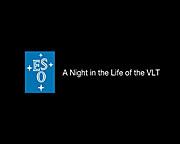Persbericht
The Perfect Science Machine
ESO celebrates 10 years since First Light of the VLT
27 mei 2008
Today marks the 10th anniversary since First Light with ESO's Very Large Telescope (VLT), the most advanced optical telescope in the world. Since then, the VLT has evolved into a unique suite of four 8.2-m Unit Telescopes (UTs) equipped with no fewer than 13 state-of-the-art instruments, and four 1.8-m moveable Auxiliary Telescopes (ATs). The telescopes can work individually, and they can also be linked together in groups of two or three to form a giant 'interferometer' (VLTI), allowing astronomers to see details corresponding to those from a much larger telescope.
"The Very Large Telescope array is a flagship facility for astronomy, a perfect science machine of which Europe can be very proud," says Tim de Zeeuw, ESO's Director General. "We have built the most advanced ground-based optical observatory in the world, thanks to the combination of a long-term adequately-funded instrument and technology development plan with an approach where most of the instruments were built in collaboration with institutions in the member states, with in-kind contributions in labour compensated by guaranteed observing time."
Sitting atop the 2600m high Paranal Mountain in the Chilean Atacama Desert, the VLT's design, suite of instruments, and operating principles set the standard for ground-based astronomy. It provides the European scientific community with a telescope array with collecting power significantly greater than any other facilities available at present, offering imaging and spectroscopy capabilities at visible and infrared wavelengths.
The first scientifically useful images, marking the official 'First Light' of the VLT, were obtained on the night of 25 to 26 May 1998, with a test camera attached to "Antu", Unit Telescope number 1. They were officially presented to the press on the 27 May, exactly ten years ago. Since then, all four Unit Telescopes and four Auxiliary Telescopes went into routine operations and the number of instruments has continued to grow, to fill all the possible positions in the telescopes where instruments can be attached.
In 2007, about 500 peer-reviewed papers using data collected with VLT and VLTI instruments at Paranal were published in scientific journals. Since the start of science operations, in April 1999, the VLT has led to the publication of more than 2200 refereed papers, an average of about one paper published every single working day.
"The combination of high operational efficiency, system reliability and uptime for scientific observations results in very high scientific productivity," says Andreas Kaufer, director of the La Silla Paranal Observatory.
The VLT and VLTI have contributed to all areas of astronomy, including the nature of dark matter and dark energy; the extreme physics of gamma-ray bursts and supernovae; the formation, structure and evolution of galaxies; the properties of exoplanets, Solar System objects, star clusters and stellar populations, the interstellar and intergalactic medium, and of super-massive black holes in galactic nuclei, in particular the one in the Galactic Centre; and the formation of stars and planets.
The stunning scientific success of the VLT has attracted new member states to ESO. In the past decade Portugal joined (in 2001, after a ten-year associate status), followed by the United Kingdom (2002), Finland (2004), Spain (2006) and Czechia (2007). Austria also announced its intent to join later this year.
Another measure of success is the number of observing proposals made every year for the use of the VLT, which is now above the 1900 mark. On average, the amount of time requested to use the VLT is 6 times higher than what is available.
The VLT will continue to increase in power over the next decade. The first of the second-generation VLT instruments, X-Shooter, will come online this year, with KMOS, SPHERE and MUSE to follow, together with multiple laser guide stars, an adaptive secondary mirror on Yepun (UT4), and one or more third-generation instruments, including an ultra-stable high-resolution spectrograph at the combined focus. The VLTI will also be equipped with second-generation instruments.
Clearly, the VLT's story has only begun.
Meer informatie
The VLT was designed from the start as an integrated system of four 8.2m telescopes, including the possibility to combine the light from individual telescopes for optical interferometry, enabling stupendous spatial resolution. First light on Antu occurred in May 1998, with Kueyen, Melipal and Yepun following soon after. Most of the VLT and VLTI instruments were built in close collaboration with institutes in the member states. The first-generation instrument suite was completed in 2007 with the commissioning of CRIRES. The Paranal arsenal includes turnkey adaptive optics systems and a rapid-response mode to react to fast transient events. Recently, the near-infrared imager HAWK-I was added as a 'generation-1.5' instrument.
See the amazing posters and videos!
Contact
Henri Boffin
ESO
Garching, Germany
Tel: +49 89 3200 6222
E-mail: hboffin@eso.org
Valentina Rodrigue
ESO
Chile
Tel: +56 2 463 3123
E-mail: vrodrigu@eso.org
Over dit bericht
| Persberichten nr.: | eso0816 |
| Legacy ID: | PR 16/08 |
| Naam: | Very Large Telescope |
| Type: | Unspecified : Technology : Observatory : Telescope |
| Facility: | Very Large Telescope |





